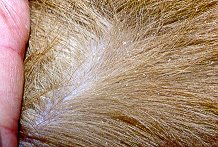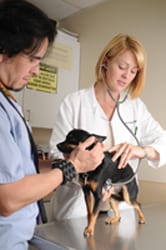Oct 5, 2020
Please keep you dog healthy and go to the vet! Also, if you are rescuing a dog.
By T. J. Dunn, Jr., DVM
It is always nice to know what to expect when you visit the veterinarian. Why? Because nobody likes surprises. So what what is going through the doctor's mind when your dog (or cat) is presented.
Let's just say you came in for your pet's routine yearly vaccination. Usually this is a good time for the doctor to take a really close look at your pet -- a good time to do an annual physical exam.
Written notes on the patient's medical chart are absolutely necessary in order to maintain a good medical history. So when the doctor isn't probing and pulling, there will be some written data being recorded. Later this information is transferred to a computerized program that sorts and organizes yearly reminders, prescription data, important patient events or surgeries and billing data.
Computers are an excellent way for the veterinarian to access current information on new techniques, medications and procedures. Plus, as a way to access continuing education references, the computer and Internet have opened up libraries of information on dog (and cat) care.
A good physical exam includes taking the patient's temperature. Normal temperature for a dog or cat varies between 101 and 102.5 degrees; that's a bit higher than our normal temperature. So if you see the veterinarian lift the pet's tail up and come at it with the thermometer, don't be shocked! The temperature is taken rectally and causes no discomfort. Every so often a seemingly healthy pet tips off the veterinarian that something isn't quite right simply by having an elevated temperature.
 Skin and coat are really excellent indicators of the
pet's health status. Look at this dog's coat and you can see right
away that there is something wrong. The coat should be shiny,
not brittle and coarse, and the skin should be clean and not greasy
and flaky.
Skin and coat are really excellent indicators of the
pet's health status. Look at this dog's coat and you can see right
away that there is something wrong. The coat should be shiny,
not brittle and coarse, and the skin should be clean and not greasy
and flaky.
The vast majority of skin and coat problems are associated with grain-based diets of poor quality and during the physical exam your veterinarian should inquire about the pet's diet. Two weeks on a meat-based diet and this dog will often look, feel and act much better. (Visit our nutrition section for some good advice on the matter.)
Many types of dermatological problems are avoided if the dog or cat is consuming an optimum diet. In some cases, adding a supplement such as, a mega fatty acid supplement is the key factor in avoiding repeated episodes of hot spots and other skin afflictions.
 Your veterinarian should examine both ears,
too. Obvious infections and allergies are problems the owner can
see, like the infected ear on this dog. But often, deep in the ear
canal is where infections can start and if noticed early, can be
eliminated before they get to the stage where the ears look like
what you see in the photo (on the right).
Your veterinarian should examine both ears,
too. Obvious infections and allergies are problems the owner can
see, like the infected ear on this dog. But often, deep in the ear
canal is where infections can start and if noticed early, can be
eliminated before they get to the stage where the ears look like
what you see in the photo (on the right).
Many dogs (and cats) suffer from allergies. Skin and ear infections are commonly the result of repeated allergic episodes. The doctor will show you how to clean the ears and prescribe the right medication if signs of an infection are present. Check your dog's (and cat's) ears and look for any signs of disease.
 Every good exam includes getting that
stethoscope against the chest and listening to the lungs and paying
close attention to the heart sounds. Dogs seldom get pneumonia.
Much more common are heart rhythm and heart valve problems. The
first way to gain information about a dog's (or cat's) heart is to
listen. (If your veterinarian seems not to be listening to you
while the stethoscope is plugged into his/her ears, don't be
insulted!) If any deviation from normal is detected, further workup
is a good idea. A cardiac workup usually entails an EKG to assess
the electrical activity of the heart and X-rays or an
echocardiogram to evaluate the heart's size and shape.
Every good exam includes getting that
stethoscope against the chest and listening to the lungs and paying
close attention to the heart sounds. Dogs seldom get pneumonia.
Much more common are heart rhythm and heart valve problems. The
first way to gain information about a dog's (or cat's) heart is to
listen. (If your veterinarian seems not to be listening to you
while the stethoscope is plugged into his/her ears, don't be
insulted!) If any deviation from normal is detected, further workup
is a good idea. A cardiac workup usually entails an EKG to assess
the electrical activity of the heart and X-rays or an
echocardiogram to evaluate the heart's size and shape.
A careful evaluation of the abdomen must be a part of the physical exam. Every veterinarian has made surprising discoveries while examining "normal" dogs (and cats). Many owners were shocked to find out that their pet had only one normal kidney, or was harboring an undiscovered tumor or was pregnant! Bladder stones, for instance, can be discovered during a routine physical exam. So in addition to feeling what's on the outside of the pet, what's inside is just as important.
Every good physical exam must include a look into the pet's mouth -- that is if the pet is willing! Oral hygiene (see our article on dentistry) is one of the most overlooked aspects of pet health care. The mouth can harbor infected gums, loose teeth, objects stuck between teeth, tumors and all sorts of other surprises. And often the pet shows no signs of discomfort from even serious oral abnormalities. Older dogs (and cats) especially may have oral hygiene difficulties that would vastly improve if dental and oral treatment was instituted. Be sure the veterinarian takes a look!
Although the eyes may not need a thorough exam where the veterinarian inspects the interior of the eye with special instruments, at least a close inspection of the visible eye structures and lids is a part of a complete physical exam. Early cataract formation may be detected, any haziness on the surface of the cornea can be detected and inflammation of the surrounding eye structures can be assessed. The most common difficulties are simple irritations that result from pollen, dust and contact with grasses.
Finally, the paws and toenails should be examined, and any really long nails should be clipped shorter (see How to Trim Toenails). Pad injuries are usually quick to heal and it is a wonder that dogs (and cats) don't cut and puncture their pads more often than they do.
Now that your pet has had a head-to-toe examination, you and the veterinarian will feel more confident that the pet is healthy. Now the challenge is to keep the pet well!
Image: Courtesy of AVMA

